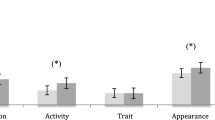Abstract
The degree to which 56 white male participants changed their self-presentation of gender role attitudes to females was investigated as a function of a female partner's desirability and gender role attitudes. It was predicted from previous theory and research that males would be highly motivated to change their self-presentation to appear more similar to a desirable women described as either traditional or nontraditional in her gender role attitudes, but would not be similarly motivated when expecting to interact with an undesirable woman. The results supported the predicted findings and replicated the findings of Zanna and Pack [(1975) “On the Self-Fulfilling Nature of Apparent Sex-Differences in Behavior,” Journal of Experimental Social Psychology, Vol. 11, pp. 583–591], who studied the behavior of female participants. The role of expectancies and the context in which interactions between men and women occur are important to understanding gender-linked behavior and attitudes.
Similar content being viewed by others
References
Allison, D. B., Gorman, B. S., & Primavera, L. H. (1993). Some of the most common questions asked of statistical consultants: Our favorite responses and recommended readings.Genetic, Social, and General Psychology Monographs, 119 153–185.
Baumeister, R. F. (1982). A self-presentational view of social phenomena.Psychological Bulletin, 91 3–26.
Baumeister, R. F. (Ed.) (1986).Public self and private self. New York: Springer-Verlag.
Baumeister, R. F., & Tice, D. M. (1986). Four selves, two motives, and a substitute process self-regulation model. In R. F. Baumeister (Ed.),Public self and private self. New York: Springer-Verlag.
Cohen, J., & Cohen, P. (1983).Applied multiple regression/correlation analysis for the behavioral sciences. Hillsdale, NJ: Erlbaum.
Deaux, K., & Major, B. (1987). Putting gender into context: An interactive model of gender-related behavior.Psychological Review, 94 369–389.
Forsyth, D. R., Riess, M., & Schlenker, B. R. (1977). Impression management concerns governing reactions to a faulty decision.Representative Research in Social Psychology, 8 12–22.
Fried, R., & Major, B. (1980, April).Self-presentation of sex-role attributes to attractive others. Paper presented at the meeting of the Eastern Psychological Assocation, Hartford, CT.
Green, P. E. (1978).Analyzing multivariate data. Hinsdale, IL: Dryden Press.
Goffman, E. (1959).The presentation of self in everyday life. Garden City, NY: Doubleday Anchor.
Gove, W. R., Hughes, M., & Geerken, M. R. (1980). Playing dumb: A form of impression management with undesirable side effects.Social Psychology Quarterly, 43 89–102.
Huck, S. W., & McLean, R. A. (1975). Using a repeated measures ANOVA to analyze a pretest-posttest design: A potentially confusing task.Psychological Bulletin, 82 511–518.
Jones, E. E. (1964).Ingratiation. New York: Appleton-Century Crofts.
Jones, E. E., & Pittman, T. S. (1982). Toward a general theory of strategic self-presentation. In J. Suls (Ed.),Psychological perspectives on the self (Vol. 1). Hillsdale, NJ: Erlbaum.
Leary, M. R., & Kowalski, R. M. (1990). Impression management: A literature review and two-component model.Psychological Bulletin, 107 34–47.
Mazzella, C., Durkin, K., Cerini, E., & Buralli, P. (1992). Sex role stereotyping in Australian television advertisements.Sex Roles, 26 243–259.
Mori, D., Chaiken, S., & Pliner, P. (1987). “Eating lightly” and the self-presentation of femininity.Journal of Personality and Social Psychology, 53 693–702.
Schlenker, B. R. (1980).Impression management: the self-concept, social identity, and interpersonal relations. Monterey, CA: Brooks/Cole.
Schlenker, B. R. (1985). Identity and self-identification. In B. R. Schlenker (Ed.),The self and social life. New York: McGraw-Hill.
Schlenker, B. R., & Weigold, M. F. (1990). Self-consciousness and self-presentation: Being autonomous versus appearing autonomous.Journal of Personality and Social Psychology, 59 820–828.
Snyder, M. (1984). When belief creates reality. In L. Berkowitz (Ed.),Advances in experimental social psychology (Vol. 18). New York: Academic Press.
Snyder, M. (1987).Public appearances/private realities. New York: W. H. Freeman.
Snyder, M., & Swann, W. B., Jr. (1978). Behavioral confirmation in social interaction: From social perception to social reality.Journal of Experimental Social Psychology, 14 148–162.
Snyder, M., Tanke, E. D., & Berscheid, E. (1976). Social perception and interpersonal behavior: On the self-fulfilling nature of social stereotypes.Journal of Personality and Social Psychology, 35 656–666.
Tedeschi, J. T. (1986). Private and public experiences and the self. In R. F. Baumeister (Ed.),Public self and private self. New York: Springer-Verlag.
von Baeyer, C. L., Sherk, D. L., & Zanna, M. P. (1981). Impression management in the job interview: When the female applicant meets the male (chauvinist) interviewer.Personality and Social Psychology Bulletin, 7 45–51.
Word, C. O., Zanna, M. P., & Cooper, J. (1974). The nonverbal mediation of self-fulfilling prophecies in interracial interaction.Journal of Experimental Social Psychology, 10 109–120.
Zajonc, R. B. (1965). Social facilitation.Science, 149 269–274.
Zanna, M. P., & Pack, S. J. (1975). On the self-fulfilling nature of apparent sex-differences in behavior.Journal of Experimental Social Psychology, 11 583–591.
Author information
Authors and Affiliations
Additional information
We wish to thank Susan Bergmann, Ken DeBono, William Graziano, Brenda Major, and Richard Moreland for their helpful comments on earlier versions of this report.
Rights and permissions
About this article
Cite this article
Morier, D., Seroy, C. The effect of interpersonal expectancies on men's self-presentation of gender role attitudes to women. Sex Roles 31, 493–504 (1994). https://doi.org/10.1007/BF01544203
Issue Date:
DOI: https://doi.org/10.1007/BF01544203




